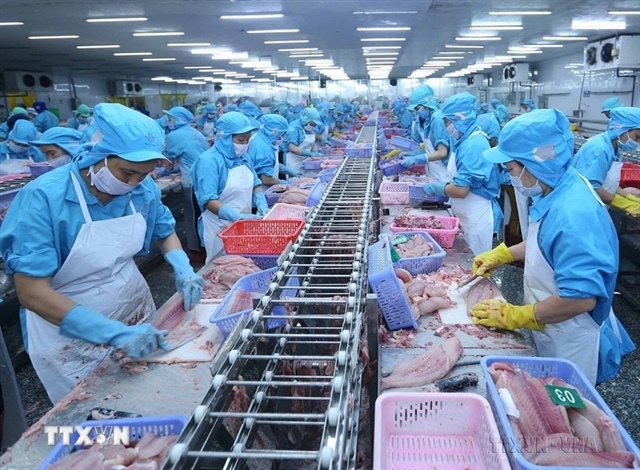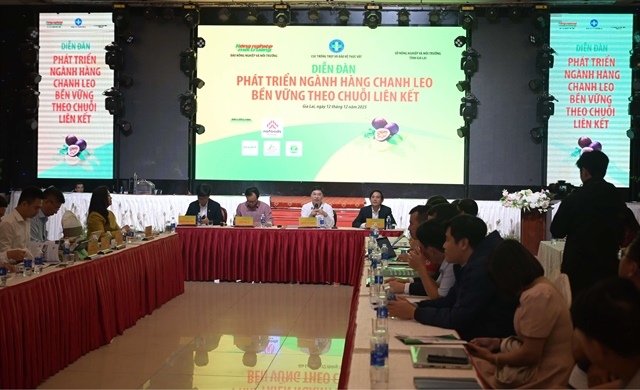Cooperation crucial to build competent auto industry
Cooperation crucial to build competent auto industry
As Vietnam makes strides to become a developed country by 2045, the number of personal vehicles is constantly rising. To develop the local automobile industry, a strong network of localised supporting manufacturers is required. Yet, domestic supporting industries are still weak, leaving the Vietnamese automobile industry at the bottom of the global supply chains.

Local automobile businesses are dependent on major foreign car manufacturers and their core technologies, a sticking point for true progress, photo Le Toan
|
Vietnam has received praise for its control of the pandemic, which has also contributed to its prestige among South Korean businesses. “Vietnam’s auto parts sector has reached an export scale of $5 billion and an import volume of $4 billion, thus attracting many South Korean businesses during the past three years,” said Lee Jong Seob, president of the Korea Trade-Investment Promotion Agency (Kotra) in Southeast Asia-Oceania and general director of its branch in Hanoi. Seob came to Vietnam under a special entry programme nine months ago.
According to Seob, Vietnam’s auto part exports are in the high growth group. In 2020, these exports grew by 48.6 per cent but “have not yet entered a stable period”, Seob pointed out, adding that “the development of the auto-business in Vietnam is based on the understanding of the government’s policymakers, promoting a business strategy that is consistent with the reality of Vietnam.”
Lagging behind
In mid-April, VinFast – a subsidiary of Vingroup – announced that it would sell three electric car models in the US market in 2022. Previously, VinFast introduced the Sedan Lux A 2.0 and SUV models. The Lux SA 2.0 participated in the international exhibition of the Paris Motor Show, one of the largest auto events in the world, and received an enthusiastic reception from the international public.
Vietnam may already be on the map of the world’s auto industry, but there is still a lot to do to gain a firm foothold in the global market, such as the right policies to develop the production of auxiliary automobile products.
A panorama of Vietnam’s auto industry was faithfully described by Pham Tuan Anh, deputy director of the Ministry of Industry and Trade’s (MoIT) Industry Agency at a seminar hosted by the ministry’s Trade Promotion Agency and Kotra that took place last week.
Vietnam’s car production has increased steadily in recent years, from around 287,000 vehicles in 2018 to 323,000 in 2020 – figures which include manufactured and assembled vehicles. The responding growth rate of the industry amounted to 2 per cent per year. However, despite the increase, Vietnam’s automobile industry remains behind other regional countries such as Thailand, Indonesia, and Malaysia.
Vietnam has 50 companies operating in automobile assembly, 45 companies manufacturing chassis and vehicle bodies, and over 200 companies producing spare parts, data from the MoIT shows. However, local businesses are only participating in the lower ends of the value chains in the automobile industry and are heavily dependent on global automobile manufacturers as they are not yet proactive in the development of core technologies.
The production and assembly of Vietnamese automakers have not yet met the criteria in the global industry and have not created links among businesses in manufacturing, assembling and spare parts, as well as with large-scale suppliers of raw materials.
While some companies are participating in the global supply chain, domestic automakers are still dependent on technological factors and the designation and distribution decisions of major manufacturers worldwide. Similarly, domestic suppliers only produce basic components, mainly for welding and painting.
Meanwhile, one of the MoIT’s regulations on the development of the country’s supporting industries lists conditions for companies to enjoy tax incentives. The Industry Agency’s deputy director Anh said, “South Korean supporting businesses make good use of an overwhelming number of incentives from the Vietnamese government’s auto industry development policy.”
The domestic automobile industry – with one of its focal points being spare parts – is one of the important industries for the nation’s industrialisation and has thus been given special incentives by the government, such as the prime minister’s Decision No.1168/QD-TTg from 2014 and the new Law on Investment, which reaps not just investment incentives for the industry but also additional ones to develop assembly activities.
Roadmap for localisation
Vu Ba Phu, director of the MoIT’s Trade Promotion Agency, sees a great opportunity for Vietnamese industrial parks and manufacturing enterprises to connect with South Korean businesses and invest in and cooperate in developing the value chain manufacturing auto parts.
In Vietnam, the production capacity of Hyundai Thanh Cong reaches 100,000 units. “We plan to develop more auto parts in Vietnam as the government has issued policies to focus on localisation,” said Yang Yun Goo, general director of Hyundai Thanh Cong.
Currently, the company does not directly manufacture auto parts itself but cooperates with local businesses to gather supplies of components.
The government already has preferential programmes for imported parts. However, the support of these programmes is not enough to lower car prices as the current tax remains relatively high compared to regional countries.
As the nation is further opening its market, Vietnam signed many free trade agreements (FTAs), but the implementation of technical factors under these schemes has received many reactions from several countries around the world.
Regulations on importing vehicles into Vietnam are an example of the remaining barriers. Luong Duc Toan, deputy director of the Industry Agency’s Department of Processing and Manufacturing, believed that Vietnam has been “unlucky”, similar to Thailand, when developing its industry at a time of blossoming bi- and multilateral FTAs as well as increased barriers. However, the application of technical measures by the Thai government has not suffered as many harsh reactions as Vietnam.
According to Toan, regulations on the production of spare parts imported by the Thai government in the 1980s did not receive any negative response. At that time, investing in manufacturing components in Thailand always followed the conditions of the supply chain.
The kingdom’s market capacity of around one million vehicles per year has also been an important factor contributing to the development of supporting industries and a sharp reduction in the cost of domestically produced vehicles.
Thailand had chosen the best time to become a country with a developed automobile industry in ASEAN, Toan said, with most major automakers wanting to enter Thailand as they turned the country into a car hub.
Meanwhile, Vietnam’s consumption of about 600,000 vehicles per year will increase to one million units by 2030. Companies like Hyundai Thanh Cong see this the reason to open cooperation with partners and speed up the localisation of spare parts manufactured in Vietnam as they hope that the localisation rate will increase to 40 per cent.
“We have had many visitors looking for opportunities to cooperate with spare part manufacturers in Hanoi and other regions,” said Kim Kwang Young, regional deputy director of Hyundai Thanh Cong. “The localisation rate of 40 per cent cannot be achieved in the short term. Instead, the government needs a roadmap to develop supporting automotive industries sustainably.”
Currently, the Vietnamese market is still small, and even if it is localised, the costs will not be reduced in the short term but may even increase over time.
Young pointed out that it may be simpler and less risky to let foreign enterprises invest in Vietnam and import components for assembly than building ancillary factories. However, the initial investment costs are huge, and these procedures also take a lot of time. That is why foreign businesses remain cautious in expanding investments in Vietnam.
According to Young’s observations, domestic manufacturers do not have much incentive to import complete units. “On the contrary, we have to bear many costs related to building factories or training workers. This situation leads to difficulties for businesses who want to invest in the Vietnamese market,” he added.
Kim also hopes that the government will soon have appropriate incentives to develop a supporting industry network, helping businesses of both countries to use each other’s products, which could benefit to local customers and contribute to the development of Vietnam’s automobile industry.



























